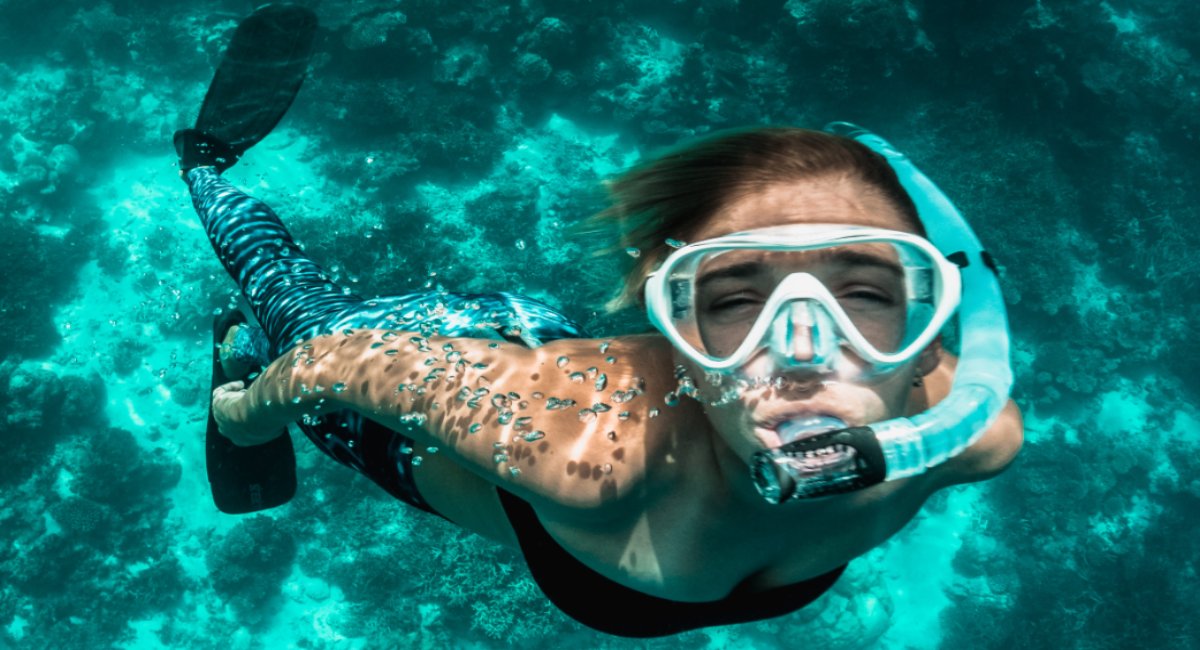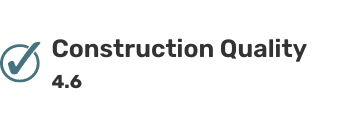Snorkeling is the act of swimming on or through a body of water while equipped with a diving snorkeling mask, a shaped breathing tube called a snorkel and usually fins. When snorkeling one spends time observing the ocean beneath them, looking at marine life and landscapes.
Snorkeling can be done by staying only on the surface of the water. For those wishing to do this with ease, or those who are not confident swimmers, wearing a snorkel vest that inflates to keep you afloat is a good idea. However, those wanting to get a closer look can also swim briefly under the surface of the water. This is where snorkeling can merge into freediving.
Freediving relies on holding one’s breath until resurfacing – the difference is that most freedivers are excellent swimmers and have a good idea of their breathing techniques. For those more focused on snorkeling – keeping underwater swims brief is recommended for health and safety reasons. All the most important facts are included in this Snorkeling for Beginners review!
SNORKELING FOR BEGINNERS
Quick Navigation
- What is the Difference Between Snorkeling and Scuba Diving?
- How Does Snorkeling Work?
- Snorkeling Tips for Beginners
- How to Use a Snorkel Correctly
- How to Breathe While Snorkeling?
- What is the Best Snorkel for Beginners?
- Where to go to Snorkeling?
- How to Clear your Mask While Snorkeling
- What is the Best Snorkeling Mask for Beginners?
- What are the Best Snorkeling Fins for Beginners?
- FAQs
What is the Difference Between Snorkeling and Scuba Diving?
Snorkelers use a snorkel to breathe but it can only bring air to the swimmer if they remain to the surface. As such, snorkeling uses an infinite amount of air.
Meanwhile, scuba diving takes place below the surface of the water, rendering a snorkel useless. Instead, a scuba diver carries their air with them in a tank on their back. The air is brought to them through hoses and a mouthpiece, which has a purge valve. Scuba diving has a finite amount of air (as much as in their scuba tank).
How Does Snorkeling Work? Snorkeling for beginners
So, how do you snorkel? Snorkeling is more than just putting on a mask and snorkel and hopping into a nearby body of water. While that may answer the question “what is snorkeling,” it doesn’t address all the other important aspects of the snorkeling process.
Preparation is important. Finding good gear for your body, testing and practicing with it, and scoping out your intended location spots for snorkeling are all important beginning steps. Snorkeling is also not a solo sport. So, find a buddy and jump in with a mask and snorkel and you’re snorkeling properly!
Snorkeling Tips for Beginners
Tip #1. Choose your Mask and Snorkel Wisely
One of the best snorkeling tips for beginners is to take the time to choose a mask that fits your face and a snorkel that fits your mouth. With masks and snorkels, there are a few things to look out for;
Some masks have wider or higher nose pockets, which can accommodate broader or higher nose bridges. Something else to consider is the actual width of the mask. Women and children often need normal to slim masks, while men may need normal to extra-wide masks; it all depends on the shape of your face. If a mask fits it can stay on your face with a gentle breath in – sealing it to your face for a few seconds – before falling.
Regarding the snorkel, make sure that the mouthpiece can reach your lips easily and that the actual mouthpiece fits your bite comfortably.
Tip #2. Add Necessary Accessories
For most snorkelers, but especially beginners, there are a few necessary accessories.
Fins. Most snorkelers use fins to propel themselves through the water. Fin type is largely up to the location, personal preference, or packing restrictions if traveling. Often, local dive shops or hotels will rent fins.
Flotation Device. Usually, a flotation device is a bright yellow or orange inflatable vest. These help snorkelers conserve energy, remain highly visible, and feel more confident in the water if they are nervous or poor swimmers. Other flotation devices include paddleboards or arm floaties as needed for kids snorkeling equipment.
Rash Guard. While snorkeling you may feel like you’re nice and cool, temperature-wise. However, the sunshine is magnified on the surface of the water and you can easily get a bad sunburn on your entire backside. Wearing a rash guard helps prevent sunburn and also helps protect you from accidentally brushing your arm against something painful like a rock or stinging coral.
Tip #3. Test Gear/Practice Beforehand
Many hotels or dive shops may offer snorkeling classes. These snorkeling lessons are usually aimed at snorkeling for beginners, which involves practicing with gear before getting into the ocean. A typical snorkeling class may involve learning how to fit, clean, and use a mask, how to attach and use a snorkel, and how to wear and use fins and an inflatable vest.
If you want to take matters into your own hands, consider searching “snorkeling near me,” “snorkeling classes near me” or “snorkeling lessons near me” on Google. That way, you can find snorkel lessons with your fellow beginners.
Otherwise, you can learn a lot about a specific snorkel technique by watching snorkeling guides on YouTube, or from an online diving and snorkeling magazine such as iDiveblue. Then, you can practice what you’ve learned at a local pool using your gear.
Tip #4. Scope Out the Location
When you first learn to snorkel, it is best to start snorkeling from a sandy shore into gentle or no waves. This will provide the best possible chance for you to enjoy yourself without having to worry about other factors like waves, currents, and drop-offs.
When choosing a specific location, one of the most important snorkeling tips is to check out your intended spot, both in-person and online before snorkeling, if possible.
My snorkeling guide is TripAdvisor. Type in “[the beach you’re searching for] + TripAdvisor” and more likely than not there will be reviews about it. These reviews are completely honest and allow you to search for certain elements such as visibility, current, difficulty, and so on. These reviews can help you make the most of your snorkeling location.
Also, always scope out the location before hopping into the water. Where are the best entry and exit points? Are there lifeguards nearby? Is there a protecting reef? These are important things to think about.
Tip #5. Check the Weather Forecast
Weather heavily impacts snorkeling conditions. Rain and wind can damage or ruin visibility. If you have the option, don’t snorkel on or the day after rainy or windy weather. Another thing to note is that seasonal weather can also influence safe snorkeling conditions. Winter weather patterns of heavier rains and winds can create strong currents and riptides in places that are fine during the summer. This is where it is very important to check reviews of snorkeling spots beforehand, especially as a beginner.
Tip #6. Buddy Up
Find a friend and snorkel together. It’s a great idea not only for safety but also for general enjoyment. Any time you’re out in the water, it is a good idea to have a buddy or two or three with you. They can help you if you get into trouble, notice if you’re getting tired or sunburned, and also point out things to see that you may have missed.
Just make sure to choose a buddy who has roughly the same snorkeling goals you do. If you plan to have fun in the shallower coral areas but they plan to swim for the outer reef and do some light freediving, it won’t be a great pairing. You don’t want to feel forced into a situation outside of your comfort zone, and they don’t want to miss out on their goal either. Being honest about your limits will help you find a well-matched buddy.
Tip #7. Just Keep Swimming (and Breathing) Calmly
A big part of snorkeling training is being calm. Reading this now, you may be thinking, “Yeah right, sure. How hard could that be?” However, there are many reasons why someone may panic while snorkeling. Perhaps water got into their snorkel, or their mask is leaking or fogging up and they can’t see well. Maybe their fin just came off their foot or a wave rolled over them. The important thing to remember is truly this: Just keep swimming and breathing calmly. Breathing fast or swimming fast usually makes things much worse.
Tip #8. Don’t Panic When Water Gets in Your Snorkel
Water will get in your snorkel. Even if you have a “dry” snorkel, water will get in your snorkel. The two key points when learning how to use a snorkel are to 1.) Don’t panic and 2.) Clear it. When the water gets in your mouth, just forcefully exhale and the water will be expelled. Then, resume breathing normally, taking measured, deep breaths.
Whatever you do, do not panic and rip your snorkel and mask off. That will not help you. If you need to remove your mask and snorkel, slide the mask strap down so the mask and snorkel sit around your neck, so you can place them back on later when you want to.
Tip #9. Don’t Touch Anything (Even If It Looks Friendly)
We’ve all seen Nemo and many of those tropical fish just look so friendly! Yet, when snorkeling, learning how to interact with what you see is very important. Feel free to look, take pictures or videos or even dive down a bit to get a better view. However, whether you’re on the surface or snorkel diving, do not touch anything – even if it looks friendly.
Hidey holes in rocks can hide painful urchins, stinging anemones or even creatures dangerous to fingers like crabs, lobsters, and eels. Colorful corals and other sea life can hurt you. Even places that look safe, such as sand, may hide animals such as stingrays, which would not like to be grabbed or stepped on. If you must grab something, a rocky ledge where you can see there are no living things at all is the best.
Tip #10. Mind Your Manners
An important part of well-rounded snorkeling instructions is snorkeling etiquette. There are a few different things to note here:
Watch Your Feet. Often new snorkelers may not realize just how long their legs are with fins attached. So, watch your feet. Don’t kick other people, especially in the face (yes, really — I’ve seen it countless times), and, more importantly, don’t kick coral. It takes a long time to grow, so kicking it is extremely bad.
Don’t Helicopter. In about ten feet of water or less, there’s something that happens which some people call the helicopter effect. If a snorkeler’s (or diver’s) fins are nearly touching the sandy bottom, then when they kick it stirs up the sand, just like helicopter blades. This ruins visibility for everyone. So, in shallower water, try to stay more horizontal to avoid this.
How to Use a Snorkel Correctly
In basic terms, place a mask over your face with the strap around the back of your head. The snorkel should be attached to the mask strap. Place the snorkel mouthpiece in your mouth. Place your face into the water with the snorkel top sticking up above the surface. Swim horizontally, breathing normally through the snorkel.
How to Breathe While Snorkeling?
In the perfect conditions – no waves – breathing while snorkeling underwater is easy. Put the mouthpiece of the snorkel into your mouth and breathe normally. The tricky part of beginner snorkeling is when water starts to splash. If you’re snorkeling, there is a chance that water will get in your snorkel. To breathe, you’ll need to expel that water.
One of the most common concerns snorkelers have is how to clear their snorkel effectively. To “clear” — expel the water — from a snorkel, exhale forcefully into the mouthpiece of the snorkel. This will either make the water shoot out of the top of the snorkel (most classic, J-style snorkels) or from the bottom purge valve (most flexible, semi-dry, and dry snorkels).
Also, while breathing, try to do so in a calm manner. Breathing hard and pulling in huge amounts of air could accidentally pull down the splash guard in some flexible, semi-dry or dry snorkels. When that happens, it will feel like your air is immediately cut off. To fix it, don’t panic. Just exhale gently and resume breathing normally.
What is the Best Snorkel for Beginners?
CRESSI Supernova Dry
General Impression
Cressi is one of the most reputable brands for diving and snorkeling gear. Their Supernova Dry snorkel features a dry snorkel outfitted with a special valve that prevents water from entering the snorkel via a float mechanism. A bottom purge valve allows for easy water expulsion and the snorkel’s hypoallergenic silicone is great for those with sensitive skin. Click here for more of our top snorkel picks.
Specifications
TYPE: Dry snorkel
BRAND: Cressi
WEIGHT: 6.4 ounces
MATERIALS: Silicone
PROS
- Highly flexible tube design reduces jaw fatigue
- Purge valve makes clearing the snorkel easy
- Can fold down small to fit in a BCD or carry case
CONS
- None
Where to go to Snorkeling?
The best places to snorkel for beginners include tropical locations that have relatively mild wave and current action along the shorelines. Here are some of the most highly rated snorkeling locations in the U.S.
Florida. If you’re in the continental U.S. and looking for a good place to snorkel, Florida has you covered. Key West has the third-largest coral reef system and an amazing amount of sea life including sea turtles, stingrays, and dolphins. Meanwhile, the Crystal River area has mangroves and manatees, which Florida is known for.
St. Croix, U.S. Virgin Islands. If you’re looking for that teal-dream perfect blue water, then St. Croix is it. A reef circles the island and snorkeling can be done right off the beaches. Colorful reef fish and calm snorkeling conditions make this location a perfect paradise.
Hawaii. Of course, Hawaii is one of the top snorkeling destinations in the world. Each island has a different snorkeling experience. For example, Maui is known for turtles and nature reserves (Turtle Town and Ahihi Kinau), Kauai is known for its unique underwater formations and remote locations (Tunnels and Nualolo Kai) and Oahu is known for famous locations (Shark’s Cove and Hanauma Bay). There’s also Molokini Crater and manta ray night snorkels for the bold.
How to Clear your Mask While Snorkeling
One of the most important parts of snorkeling 101 is learning how to clear your mask. After all, the point of underwater snorkeling is to see all the wildlife down there! So, what do you do to clear a foggy or leaky mask?
The first thing to determine is why your mask needs clearing. If it is leaking, then the seal is probably broken somewhere, and you may need to check for stray hairs under the mask skirt. If it is fogging up, then you need to de-fog it. While snorkeling, that means using good old spit.
There a few ways you can clear your mask while snorkeling. If you’re wearing a flotation device, roll over onto your back and lower your legs so your head is out of the water. Then adjust your mask, let water out or add spit as necessary.
If you’re not wearing a flotation device, you can do the same thing, only using your legs to keep your head above water instead of relying on an inflated vest. Or, similar to how divers clear their masks, make your body vertical and let your head bob slightly under the surface, tilt your head slightly back, keep the forehead of the mask pressed to your face and breathe out of your nose. As divers can attest, this will push any water out of the mask.
Of course, the easiest way to clear your mask is to stand up and take care of it, if possible. Only stand up if the ground under you is not alive. This means rock or sand is fine, but coral is off-limits.
What is the Best Snorkeling Mask for Beginners?
CRESSI Liberty Triside
General Impression
Cressi’s Liberty Triside mask is an all-around solid mask for both snorkelers and divers. The mask fits most faces and features a low volume design for easy clearing and equalization. The mask has three windows, increasing the field of view while minimizing feelings of claustrophobia. Plus, it comes in a variety of colors. For more of our top mask picks, click here.
Specifications
BRAND: Cressi
WEIGHT: 9.0 ounces
MATERIALS: Silicone and tempered glass
PROS
- Low volume design is easy to clear
- Three windows for the max field of view
- Inexpensive
CONS
- Very popular, so limited stock
What are the Best Snorkeling Fins for Beginners?
SEAVENGER Torpedo Fins
General Impression
The Seavenger Torpedo Fins are one of the best beginner snorkeling fins for a few reasons. First, they are compact enough to easily fit in any travel bag, or carry-on. They also have an open-heel and an easily adjustable design for the best fit and comfort. They are lightweight, perform well, and come in a variety of colors. For more of our best snorkeling fins, click here.
Specifications
BRAND: Seavenger
WEIGHT: 1.5 pounds
SIZE: 15.0 inches
BLADE TYPE: Single, short paddle
PROS
- One of the best travel fins for price
- Highly durable
- Comfortable and easily adjustable
CONS
- None
WHAT IS SNORKELING
FAQs
1. What does snorkeling mean?
“Snorkeling” means using a snorkel, which is usually a J-shaped tube that brings air to a swimmer just below the surface. To snorkel, a person must be swimming or floating on the water’s surface. Although snorkeling can temporarily mean diving below the surface, staying calmly face-down while wearing a mask and the attached snorkel can often be an amazing way to see as much as possible. Many snorkelers may also wear fins for propulsion, a rash guard for protection from the sun and other harmful elements like coral or rocks and in some cases even a flotation device.
Most swimmers use a snorkel along the surface of a body of water, such as a lake, river, pool, or ocean. The purpose of snorkeling is to look below the surface of the water, usually to see underwater life. As such, snorkeling is generally thought of as a low-intensity underwater sightseeing activity.
2. Can non-swimmers go snorkeling?
Ideally, non-swimmers should not snorkel. There are too many risk factors to create a safe environment when a person is in water over their head but doesn’t know how to swim. That being said, technically, you can snorkel even if you can’t swim. However, if you choose to do so, then you have to accept a certain level of risk.
For poor or non-swimmers who wish to snorkel using a flotation device such as an inflatable vest, is crucial. The vest will keep your body on the surface and help keep you from tiring out. Also, never go snorkeling in a place that has rip-currents or strong tides, as they can drag you away from the beach or boat. You must go with a buddy and stay near the beach or boat in case you get tired or panicked. These simple precautions can help minimize the risk.
3. How to breathe underwater with a snorkel?
Learning to snorkel is about understanding what happens with a snorkel above and below the water. At the surface, the snorkel allows you to breathe in air. Breathing in slow and steady is best. Try not to panic if some water gets into the snorkel although some snorkels have splash guards that prevent this. Those guards may close if you breathe too deeply so just try to breathe calmly.
When you dive underwater, one of two things may happen: Either your snorkel floods with water (most snorkels) or the top of the snorkel seals over, preventing water from coming in during the dive (dry snorkels). Upon resurfacing, there are two ways to “clear” (get water out of) your snorkel. If it is full of water, you may need to forcefully exhale to clear the snorkel. With classic/J-style snorkels it will clear out the top of the snorkel and out of the purge valve on the bottom of the snorkel with flexible, semi-dry, and dry snorkels.
4. How to connect a snorkel to a mask
One of the snorkeling basics you need to know is how to connect your snorkel to your mask. The instructions are simple. Place your mask on your face and put the snorkel tube in your mouth. Align the snorkel tube with the side of your face, so that the tube brushes against the mask strap. This is the location that you want to move your snorkel clip to. Once the snorkel clip is in the correct place, then you can take off both the mask and snorkel.
Slide the snorkel through the clip and voila, it is in the correct place for your face shape. To double-check this, place the mask on once again and the snorkel should be within reach of your mouth and can easily be moved to your lips with your fingers.
5. How deep is snorkeling water?
Snorkeling water depth is completely dependent upon your location. So, it can be anywhere from a few feet deep (wading into the water) to hundreds of feet deep (boat diving). However, other than very specific boat dives out to landmarks, most snorkeling locations are probably around ten to a hundred feet deep.
On the shallow end, at ten feet deep, it is far enough out to get away from any cloudy water or low visibility caused by waves lapping on the shore and the water will usually be calmer, and the visibility will be better.
On the deep end, a hundred feet is usually the max visibility anyone could hope for at the dream snorkeling destinations such as Hawaii or Florida. On a clear day, with low wave action and great weather, it is possible to see about a hundred feet down from the surface.
6. How to dive while snorkeling
Learning how to snorkel dive is remarkably easy. A snorkel dive is simply when you submerge your snorkel and mask completely underwater while snorkeling.
This means you could dip your head one or two feet underwater while your body mostly stays at the surface or you could swim down ten or twenty feet, your mask, snorkel, and entire body under the surface. Both instances are examples of a snorkeling dive.
The key point is that you are submerging your snorkel and possibly your whole body. To dive completely under the water, take a deep, calm breath and then lean your face and shoulders down into the water, kicking your legs strongly to propel yourself down into the water. This will not work if you’re wearing a strong flotation device, such as an inflatable vest. Do not try to breathe from your snorkel while underwater. When you ascend, it is important to do so in a calm, controlled manner, allowing your body to adjust with ease. When you reach the surface, clear your snorkel with a strong breath out.
Take breaks and always snorkel with a buddy. Be careful not to overdo it, as holding your breath, swimming, and being exposed to direct sun can dehydrate and exhaust you more than you may think. Extended snorkeling and snorkel diving can lead to heatstroke, heat exhaustion, or shallow water blackouts in extreme cases.
7. Where to Buy Snorkeling Gear?
One of the best places to buy snorkeling gear is Amazon, both because it is easy to search, order and have it delivered, but also because of Amazon ratings. If you’re just starting, Amazon is a great way to go. Later on, once you develop your snorkeling style and preferences, you can buy gear directly from manufacturers or ask your local scuba shop to order the piece in for you, often at a discount.
REACH OUT
As always, we create our content with you, fellow adventurers, in mind. So, how’d we do? Did you find this informative? Did it help you make a decision? Did we miss anything? We’d love to hear from you below. Thanks for reading and we hope your next adventure is a great one!













